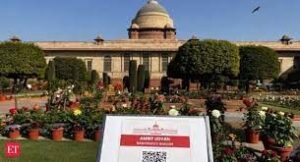Published on: January 31, 2023
Amrit Udyan
Amrit Udyan
Why in news? The Mughal Gardens at Rashtrapati Bhavan were renamed ‘Amrit Udyan’ in keeping with the theme of Azadi ka Amrit Mahotsav.
Highlights
- Amrit Udyan drew the inspiration from the Mughal Gardens of Jammu & Kashmir, the gardens around the Taj Mahal and miniature paintings of India and Persia
- The herbal garden, bonsai garden, central lawn, long garden and circular garden are now collectively called Amrit Udyan.
Planning
- Edwin Lutyens had finalised the designs of the Mughal Gardens
- Planting for the gardens was done during his collaborator Director of Horticulture, William Mustoe.
- Lutyens brought together two different horticulture traditions together for the gardens the Mughal style and the English flower garden.
- Mughal canals, terraces and flowering shrubs are beautifully blended with European flowerbeds, lawns and private hedges.
Style
- The style was influenced by the Persian gardens, particularly the charbagh structure, that intended to create a representation of harmony with the elements of nature.
- A defining feature of these gardens is the use of waterways, often to demarcate the various quadrants of the garden crucial to maintain the flora of the garden, and an important part of its aesthetic.
- Fountains were often built, symbolising the “cycle of life.”
- Typical features include pools, fountains and canals inside the gardens.
- Afghanistan, Bangladesh, India, and Pakistan have a number of Mughal gardens.
- In fact, Babur had described his favourite type of garden as a charbagh.
Other President contribution gardens
- President R Venkatraman added a cactus garden
- APJ Abdul Kalam added many theme-based gardens from the musical garden to the spiritual garden.
- C Rajagopalachari, the first Indian resident of Rashtrapati Bhavan, used a portion to cultivate wheat

